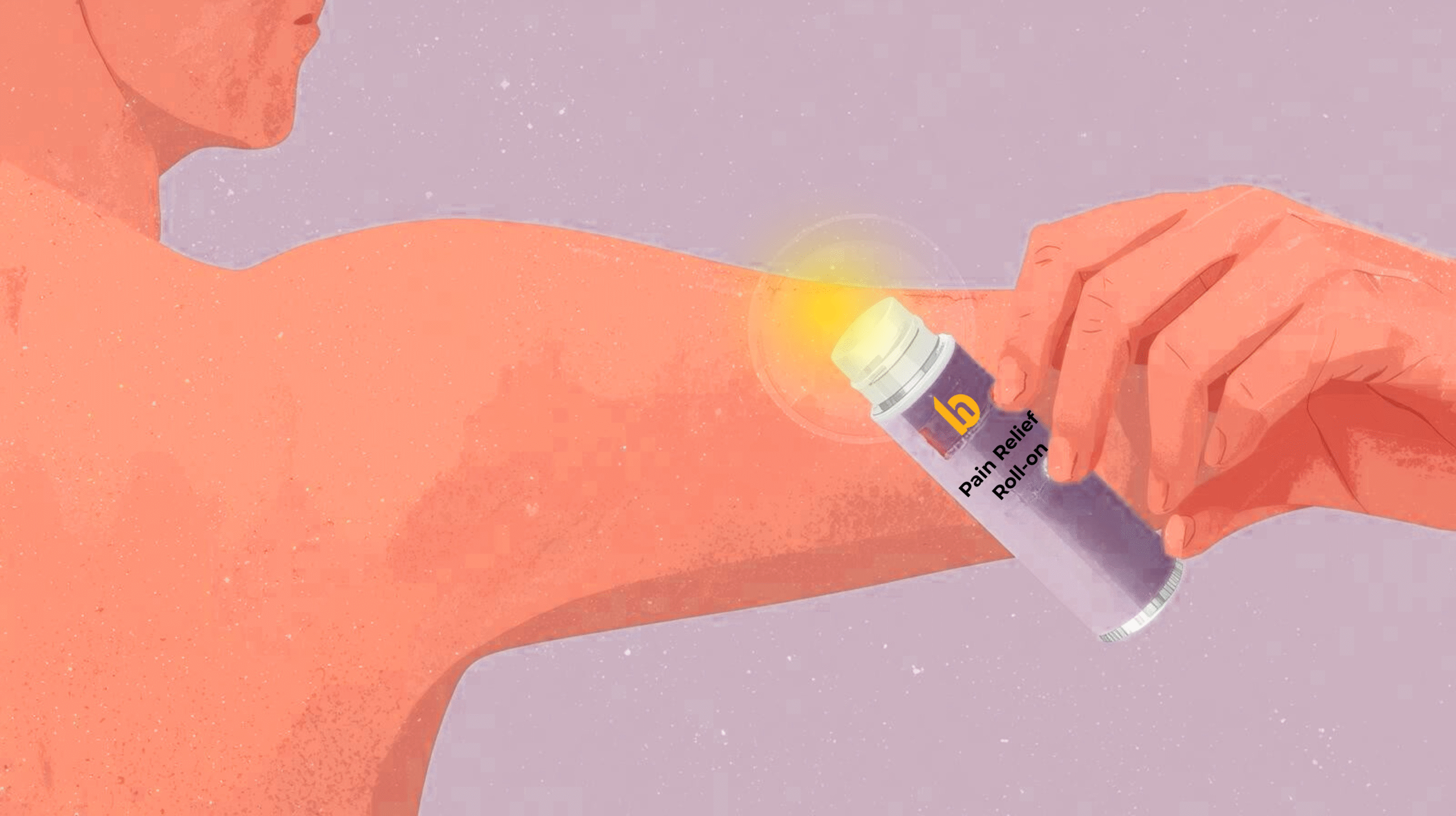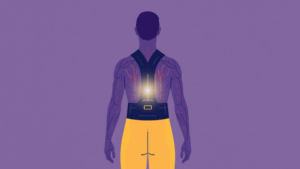Muscle pain is something almost everyone has experienced, whether it’s from sitting too long at a desk, pushing yourself too hard at the gym, or simply waking up with a stiff neck. Joint discomfort also creeps in, especially as we age, or if we’ve had an injury in the past. While oral painkillers may provide relief, they often come with side effects and aren’t always practical for everyday aches. That’s where muscle pain relief roll-ons come into the picture.
These handy, pocket-sized solutions have become a go-to for athletes, office workers, senior citizens, and even students dealing with exam stress muscle tension. The biggest advantage? A roll-on allows you to apply pain relief exactly where it hurts, without mess, without pills, and with almost instant soothing effects.
But how exactly do these roll-ons work? Are they really effective, and more importantly are they safe for everyone? Let’s dive in to understand the science, the benefits, and the best ways to use them.
What Causes Muscle and Joint Pain That Roll-Ons Can Relieve?
Muscle and joint pain can come from a variety of causes. Understanding the root helps us see why roll-ons can provide targeted relief.
1. Muscle Strain and Overexertion
Ever lifted something heavy, worked out after a long break, or done house chores that left you sore? That’s muscle strain. It happens when tiny muscle fibers tear due to overuse. While these microtears heal naturally, they cause inflammation and pain in the process. Roll-ons help by cooling or warming the area, which reduces discomfort and supports healing.
2. Sports Injuries (Sprains, Stiffness, Microtears)
Athletes often face sprains, stiffness, and repetitive strain injuries. Roll-ons are particularly popular in sports because they are easy to carry, quick to apply, and don’t interfere with performance. They allow athletes to manage minor injuries without popping painkillers every time.
3. Arthritis and Joint Inflammation
Arthritis is one of the leading causes of chronic joint pain, especially among older adults. The stiffness and swelling can make daily activities difficult. Roll-ons that contain anti-inflammatory ingredients like menthol, camphor, or herbal extracts can temporarily reduce pain and make movement easier.
4. Poor Posture and Desk Job Discomfort
If you spend hours at a computer or glued to your phone, you’ve probably felt neck pain, shoulder tightness, or lower back aches. Poor posture puts strain on certain muscles, leading to pain. A quick roll-on application during breaks can ease discomfort and help you get through the day more comfortably.
5. Stress and Tension-Related Muscle Tightness
Stress doesn’t just affect the mind, it shows up in the body too. Tight shoulders, stiff neck, or tension headaches often come from stress-related muscle contraction. Roll-ons provide a cooling or warming sensation that helps these muscles relax, offering both physical and mental relief.
How Do Muscle Pain Relief Roll-Ons Work?
At first glance, a muscle pain relief roll-on looks simple, just a small bottle with a rollerball that you glide over the skin. But inside that bottle lies a carefully crafted formula designed to deliver fast, targeted comfort. The rollerball itself also adds a light massage effect, which helps relax tension while applying the product.
Active Ingredients in Roll-Ons
Most muscle pain relief roll-ons are powered by a combination of cooling, warming, and anti-inflammatory agents. Let’s break it down:
- Menthol – Provides an instant cooling effect, numbing the pain signals sent to your brain. It also improves blood circulation in the area.
- Camphor – Known for its warming sensation, camphor increases blood flow and helps stiff muscles loosen up.
- Essential Oils (Eucalyptus, Peppermint, Wintergreen, Clove, etc.) – Many herbal roll-ons rely on natural oils with pain-relieving and anti-inflammatory properties.
- Herbal Extracts (Turmeric, Boswellia, Ashwagandha, etc.) – Ayurvedic or herbal roll-ons often include these to support long-term joint health and reduce inflammation naturally.
- NSAIDs (Non-steroidal anti-inflammatory drugs) – Some medicated roll-ons contain pharmaceutical-grade pain relievers, though these are less common compared to sprays or gels.
Mechanism: How They Soothe Pain
When you apply a roll-on, here’s what happens beneath the skin:
- Topical Absorption – The active ingredients penetrate the outer skin layers and reach the muscles and joints beneath.
- Sensory Distraction (Counterirritant Effect) – Cooling or warming sensations distract your nervous system from pain signals, giving immediate relief.
- Increased Blood Flow – By stimulating circulation, roll-ons help the body deliver oxygen and nutrients to the affected area, speeding up recovery.
- Muscle Relaxation – The light massage from the rolling action, combined with the formula, helps muscles loosen, reducing stiffness.
Can Roll-Ons Help in Preventing Pain or Injury?
Most people think of roll-ons only after the pain kicks in but they can actually be part of your preventive care routine too.
Imagine this: You’re about to hit the gym after a long day at work. Your shoulders are tight from sitting hunched over your laptop. Applying a roll-on before your workout can warm up the muscles, improve circulation, and reduce the risk of strains.
Similarly, after a run or a game of football, rolling on a cooling formula can ease post-activity soreness and speed up recovery. This is why many athletes keep one in their sports kit, it’s like a mini physiotherapist in a bottle.
Everyday Prevention Tips with Roll-Ons
- Before Physical Activity – Use warming roll-ons to loosen muscles before workouts.
- After Workouts – Cooling roll-ons reduce inflammation and stiffness.
- During Long Desk Hours – A quick application on the neck, shoulders, or lower back can prevent tension from building up.
- Traveling – Long flights or road trips can cause leg cramps and stiffness; roll-ons are discreet and convenient to carry.
Of course, roll-ons are not a replacement for good habits. Posture correction, regular stretching, hydration, and a balanced diet remain the foundation of pain prevention. But they serve as a quick, effective support system in your daily routine.
Are Muscle Pain Relief Roll-Ons Safe for Everyone?
One of the best things about roll-ons is their safety profile. Since they’re applied externally and act locally, they avoid many side effects that come with oral painkillers. Still, it’s important to understand how different age groups and users can benefit or need to be cautious.
For Older Adults
Older people often struggle with joint pain from arthritis, or back pain from age-related degeneration. Roll-ons are ideal because:
- They’re easy to apply without bending too much.
- They don’t interfere with most medications.
- They reduce dependency on strong painkillers.
Precaution: Older adults with very sensitive skin should do a patch test before regular use to avoid irritation.
For Athletes and Fitness Enthusiasts
Athletes swear by roll-ons because they’re portable and fast. Whether it’s a sprained ankle, sore calves after a marathon, or shoulder tension from weightlifting, roll-ons are a trusted companion.
Precaution: Avoid overuse; applying too frequently won’t “speed up” recovery. Stick to recommended usage.
For Children and Teens
Kids and teens can also face muscle pain, whether from sports, carrying heavy school bags, or awkward sleeping positions. However, not all roll-ons are safe for younger age groups. Many medicated or strong formulations may be too harsh.
Advice: For children, it’s best to stick to mild, herbal roll-ons and always consult a pediatrician before use.
For People with Sensitive Skin or Allergies
Some ingredients like menthol or camphor may cause a burning sensation or rash in sensitive individuals. Always:
- Test on a small patch of skin.
- Avoid using on cuts, wounds or broken skin.
- Discontinue use if irritation occurs.
Which Muscle Pain Relief Roll-Ons Are Most Trusted and Effective?
Now let’s talk about some popular roll-ons available in the market. While everyone’s body responds differently, these products are widely trusted.
1. Moov Strong Roll-On
Contains diclofenac (NSAID), menthol, and camphor; fast relief for muscle sprains and joint pain; widely available in India.
2. Amrutanjan Roll-On (Relief for Headache & Muscle Pain)
Herbal-based with menthol and eucalyptus oil; cooling effect; compact size for travel.
3. Betterhood Muscle Pain Relief Roll-On (Emerging Brand)
Blend of natural oils and anti-inflammatory agents; lightweight and non-greasy; good for daily use.
How to Choose the Right Roll-On for You
- For athletes – Go for stronger options like Moov, Icy Hot or Betterhood.
- For older adults with arthritis – Herbal roll-ons like Himalaya may be gentler and safer.
- For everyday mild pain or travel – Amrutanjan or Betterhood provide quick comfort.
- For chronic or severe pain – Look for medicated roll-ons with proven active ingredients.
What Side Effects or Risks Should You Know?
Muscle pain relief roll-ons are generally safe, but like any topical product, they may cause side effects in some cases.
Common Side Effects (Usually Mild)
- Skin Irritation – Redness, itching, or burning sensation.
- Allergic Reaction – Especially if you’re sensitive to menthol, camphor, or essential oils.
- Overheating/Cooling Sensation – Some users may find the strong sensation uncomfortable.
Safety Tips
- Always do a patch test before first use.
- Don’t apply on cuts, wounds, or broken skin.
- Avoid using on the face, eyes, or mucous membranes.
- Follow the recommended usage frequency (usually 3–4 times/day).
When Should You See a Doctor About Your Pain?
Roll-ons are great for temporary and mild to moderate pain, but they’re not a replacement for medical care. You should consult a doctor if:
- The pain lasts more than 2 weeks without improvement.
- You experience severe swelling, numbness, or weakness in the affected area.
- The pain is accompanied by fever, weight loss, or fatigue (possible underlying condition).
- Arthritis pain becomes too severe to manage with over-the-counter remedies.
Think of roll-ons as a first line of defense, if pain persists or worsens, always seek medical guidance.
Final Thoughts
Muscle pain relief roll-ons may look simple, but they pack a powerful punch. They’re small enough to fit in your pocket yet effective enough to help with everything from stiff necks to post-workout soreness. What makes them special is how quick, targeted, and convenient they are: no pills, no sticky creams, no waiting hours for relief.
Of course, roll-ons aren’t magic. They work best when paired with healthy lifestyle choices, stretching regularly, keeping good posture, staying hydrated, eating nutrient-rich foods, and giving your body enough rest. Think of a roll-on as your on-the-spot pain manager, not a cure for deeper issues.
Whether you’re an athlete, a working professional stuck at a desk, or someone managing arthritis pain, there’s a roll-on out there designed for your needs. The key is choosing wisely, using it correctly, and listening to your body.
People are also reading:
- Home Remedies for Body Pain Relief Naturally
- Ergonomic Hacks for Frequent Ride-Share Drivers
- Can Your Sitting Posture Cause Hip Misalignment
- Fast, Targeted Relief: The Science Behind Pain Relief Gel
- Knee Joint Pain Causes
- Knee Cap Uses
FAQs About Muscle Pain Relief Roll-Ons
1. Are muscle pain relief roll-ons safe for daily use?
Yes, most roll-ons are safe for daily use, as long as you follow the recommended instructions. If your pain requires you to use it more than 3–4 times a day for several weeks, it’s better to consult a doctor.
2. How long does one application last?
The relief usually lasts anywhere from 2 to 4 hours, depending on the product and severity of pain. For chronic issues like arthritis, reapplication may be needed more often.
3. Can I combine roll-ons with oral painkillers?
Yes, in most cases roll-ons can be safely combined with oral pain medication since they act locally. However, if your roll-on contains NSAIDs (like diclofenac), check with your doctor before combining with other painkillers.
4. Can children use muscle pain relief roll-ons?
It depends on the product. Herbal or mild menthol-based roll-ons are sometimes suitable for teens, but strong medicated roll-ons are not recommended for children without a doctor’s approval.
5. Which body parts can I safely apply a roll-on to?
You can apply roll-ons on the back, neck, shoulders, arms, legs, knees, and ankles. Avoid sensitive areas like the face, eyes, chest, or broken skin.
6. Can I use a roll-on before going to the gym?
Yes! In fact, many athletes use warming roll-ons before workouts to loosen stiff muscles and prevent strains. Just make sure to wash your hands afterward so you don’t accidentally touch your eyes.
7. Do roll-ons work for chronic conditions like arthritis?
They can help manage symptoms of arthritis by reducing pain and stiffness, but they won’t cure the condition. For long-term management, you’ll need a combination of medical treatment and lifestyle adjustments.
8. Are herbal roll-ons as effective as medicated ones?
Herbal roll-ons are gentler and safer for frequent use, but they may offer slower or milder relief compared to medicated roll-ons. It really depends on your personal needs and sensitivity.
References
- Menthol as a Counterirritant (Cooling Effect & Pain Relief)
Pergolizzi Jr, J.V. et al. (2018). The role and mechanism of action of menthol in topical analgesics. PubMed (NCBI).
Summary: Menthol activates TRPM8 channels, producing a cooling sensation and acting as a counterirritant to relieve pain. https://pubmed.ncbi.nlm.nih.gov/29524352/
- Overview of Topical Pain Relief Ingredients (Menthol, Camphor, NSAIDs, Capsaicin, Arnica) SELF Staff (Aug 28, 2025). The Best Muscle Pain Relief Creams for Every Ache and Knot. SELF.
Summary: Highlights common actives like menthol, camphor, lidocaine, NSAIDs, arnica, and capsaicin used in OTC topical pain relievers. https://www.self.com/story/best-muscle-pain-relief-creams - Menthol Activates TRPM8 Receptors (Extended Analgesic Insight)
Li, Z. (2022). The distinctive role of menthol in pain and analgesia. PMC (NCBI).
Summary: Menthol’s analgesic effect stems from TRPM8 activation; low to moderate concentrations ease pain, while high doses can cause allodynia. https://pmc.ncbi.nlm.nih.gov/articles/PMC9580369























